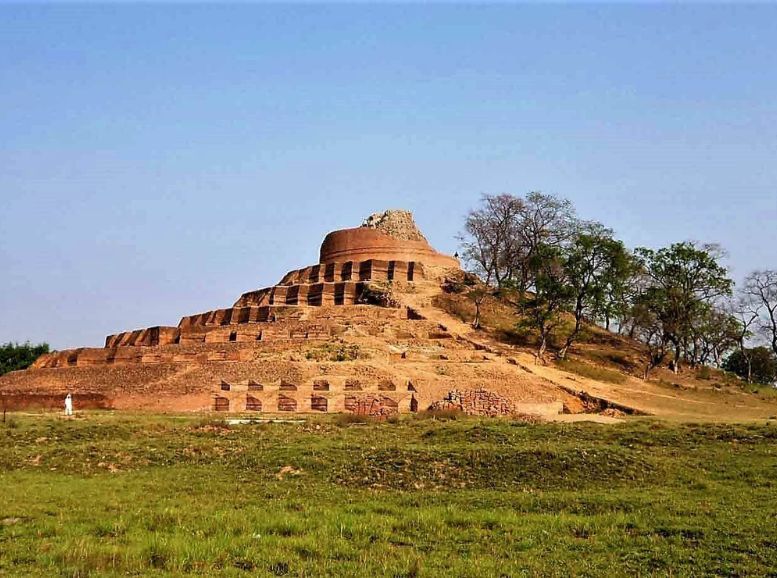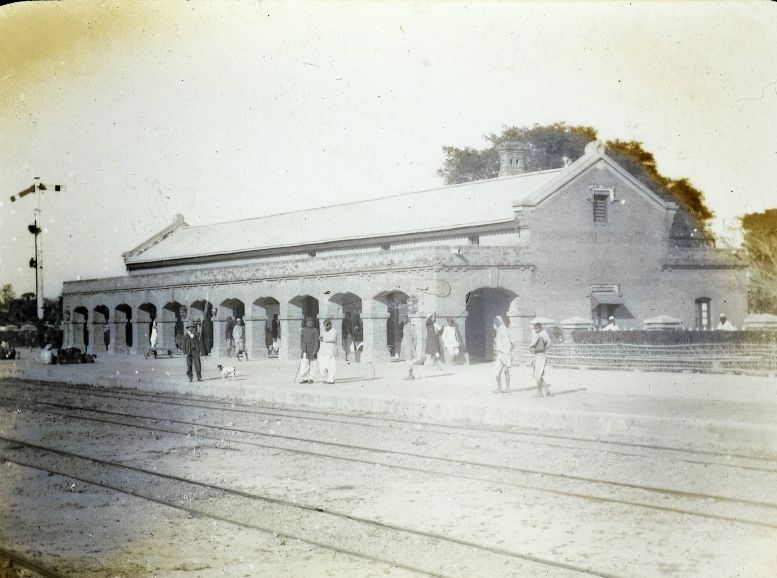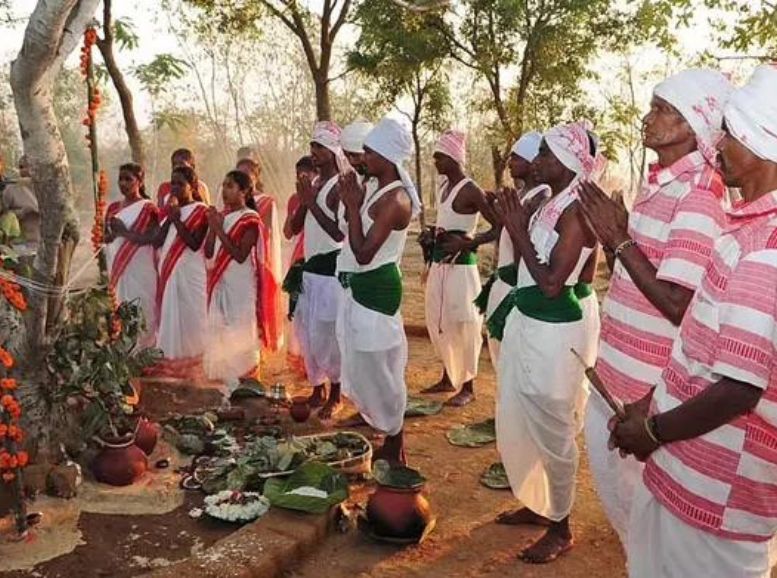Standing tall amidst the verdant landscapes of East Champaran, Bihar, the Kesaria Stupa whispers of a bygone era. This magnificent structure isn’t just any stupa; it claims the title of the world’s tallest Buddhist monument, a testament to the region’s rich cultural tapestry.
Built under the reign of Emperor Ashoka and further embellished by the Lichchavis, the Kesaria Stupa transcends mere brick and mortar. It’s a tangible link to the profound Buddhist legacy that once flourished here. As you approach this colossal wonder, a sense of awe washes over you. Its imposing height and intricate design transport you back in time.
How to reach:
By Air:
- Patna Airport: The nearest airport is Jay Prakash Narayan International Airport in Patna, roughly 110 kilometers away. This well-connected airport offers flights from major Indian cities like Delhi, Mumbai, Kolkata, and Bangalore. Taxis and buses are available from the airport to Kesaria.
By Train:
- Chakia Station: This station sits closest to Kesaria, about 30 kilometers distant. Taxis and local buses can take you to the stupa from here.
- Motihari Station: Another convenient option is Motihari Station, located around 40 kilometers away. Taxis and buses are readily available to transport you to Kesaria Stupa. Both stations connect to major cities in Bihar and neighboring states.
By Road:
Kesaria boasts good road connectivity, allowing you to reach the stupa by car or bus.
- From Patna: If Patna is your starting point, you can take a bus or hire a taxi. The journey via NH31 and NH28 typically takes 3-4 hours.
- From Motihari: Local buses and taxis connect Motihari to Kesaria. The drive takes approximately 1-2 hours via NH28.
Bus Options:
Several state-run and private buses operate between major Bihar cities and Kesaria. Frequent services ply this route from Patna, Muzaffarpur, and Motihari. The Bihar State Road Transport Corporation (BSRTC) also offers regular buses to Kesaria.
Local Transport:
Once in Kesaria, auto-rickshaws and cycle-rickshaws provide convenient options for navigating short distances within the area and reaching the stupa itself. These are readily available and affordable.
Best time to visit:
Winter (October to March):
- Temperature: Enjoy pleasant weather with temperatures ranging from 8°C to 25°C.
- Conditions: This cool and comfortable season is perfect for sightseeing and outdoor exploration. Clear skies enhance the visual experience of the stupa.
- Bonus: Winter coincides with several local festivals, offering a chance to immerse yourself in the region’s vibrant culture.
Summer (April to June):
- Temperature: Brace yourself for hot and humid weather, with temperatures reaching up to 40°C.
- Conditions: While the midday sun can be intense, mornings and evenings offer more bearable temperatures for visiting the stupa.
- Tips: Be sure to carry plenty of water, wear lightweight clothing, and apply sunscreen for protection.
Monsoon (July to September):
- Temperature: Expect moderate temperatures between 20°C and 35°C.
- Conditions: The monsoon brings heavy rainfall and high humidity, transforming the landscape around Kesaria Stupa into a lush green paradise.
- Considerations: Travel can be challenging due to wet roads and potential disruptions in transportation.
About Stupa:

In the heart of Bihar’s East Champaran district lies Kesaria Stupa, a towering testament to Buddhist history and architectural prowess. Holding the title of the world’s tallest and largest Buddhist stupa, it’s a wonder that whispers tales of ancient engineering and profound religious significance.
Emperor Ashoka laid the first stones in the 3rd century BCE, and the Lichchavis later expanded this magnificent structure. Today, it rises to a staggering 104 feet, though some believe its original height was even greater before time etched its mark. Intricate designs adorn its terraces, showcasing Buddhist relics and sculptures that speak of a bygone era.
Nearby Attractions:
Motihari:

Just 40 kilometers from Kesaria Stupa lies Motihari, a town steeped in history and culture. Literature buffs flock here to visit the preserved house where George Orwell, author of the iconic novels “1984” and “Animal Farm,” was born. Now a museum, it offers a glimpse into his life and the works that continue to shape literary landscapes.
Motihari’s significance extends beyond the literary world. It played a pivotal role in India’s freedom struggle as the birthplace of Mahatma Gandhi’s Champaran Satyagraha in 1917. This non-violent resistance movement, the first of its kind for Gandhi, proved instrumental in the fight for independence. The Gandhi Memorial stands tall in Motihari, a constant reminder of the town’s contribution.
Sarna Sthan near Kesaria Stupa:

Journey around 50 kilometers from Kesaria and discover Sarna Sthan, a revered grove holding immense cultural and spiritual significance for the local tribal communities. This sacred space serves as a place of worship and a hub for community gatherings.
Its dense foliage and serene environment create a tranquil retreat, where visitors can immerse themselves in the natural beauty and deep-rooted traditions of the region. The grove’s sanctity stems from its association with tribal deities and ancestral spirits, making it a powerful symbol of the indigenous communities’ spiritual practices.
Local Experiences:
Dive into Bustling Markets: In Chakia and Motihari, wander through lively markets overflowing with fresh produce, handcrafted treasures (textiles included!), and local delicacies. Strike up conversations with friendly vendors and soak in the infectious market atmosphere.
Witness Cultural Extravaganzas: Across East Champaran’s towns, vibrant festivals erupt with traditional music, captivating dances, and unique rituals. Immerse yourself in the colorful celebrations, a true reflection of the region’s spirit.
Unearth Historical Gems: From ancient Vaishali to Motihari and Lauriya Nandangarh, embark on a journey through time. Explore awe-inspiring monuments, pillars, stupas, and museums, each whispering tales of the region’s remarkable past.
Embrace Spiritual Tranquility: Find peace at sacred sites like Sarna Sthan and Kesaria Stupa. Participate in or simply observe local spiritual rituals and ceremonies, experiencing the profound serenity these spaces evoke.
Capture Nature’s Canvas: Venture into the picturesque countryside surrounding Kesaria Stupa. Breathe in the fresh air on leisurely nature walks, and don’t forget your camera! Capture breathtaking photographs of the region’s natural beauty and historical ruins.
Savor Local Delights: Indulge in the culinary tapestry of East Champaran. Sample iconic Bihari dishes like litti chokha, sattu paratha, thekua, and khaja at local eateries and food stalls in Chakia and Motihari. Tantalize your taste buds and discover the region’s unique flavors.
Travel tips:
Beat the Heat: Especially during the summer months, start your day early to maximize your time at each location and avoid the afternoon sun’s intensity.
Unlock Local Knowledge: Consider hiring local guides at major attractions. Their insights into the history and significance of the sites will enrich your experience and provide valuable context.
Pack Smart: Comfortable clothing and walking shoes are key. Opt for light, breathable fabrics to keep you cool, especially in warmer weather. Don’t forget a hat, sunglasses, and sunscreen for sun protection.
Stay Fueled: Carry plenty of water and light snacks to keep yourself hydrated and energized, particularly when exploring remote areas where amenities might be limited.
Respect the Culture: Be mindful of local customs and traditions. Dress modestly when visiting religious sites, and show respect for the local way of life.
Be Prepared: Cash might be necessary as ATMs and card payment options may be limited in smaller towns and rural areas. Ensure your phone is charged, and consider a power bank for longer trips.
Indulge Your Taste Buds: Don’t miss the chance to savor the delicious Bihari cuisine. Embrace the culinary adventure, but if you have a sensitive stomach, be cautious with street food.
Capture Memories: Pack a good camera or smartphone to capture the breathtaking landscapes and historical sites. Always ask permission before photographing people or religious ceremonies.
Plan for the Unexpected: Consider travel insurance to provide coverage for medical emergencies, travel delays, or unforeseen circumstances.
Smooth Transportation: Pre-book your transport and accommodation, especially during peak tourist season. Renting a car or hiring a taxi offers flexibility if you plan to visit multiple attractions.
Conclusion
Unveiling the Enchantment of East Champaran: A journey to Kesaria Stupa, a magnificent testament to the region’s rich past, is your gateway to a deeper exploration of India’s cultural and historical tapestry. From ancient wonders in Vaishali, Motihari, and Lauriya Nandangarh to the spiritual havens of Kesaria Stupa and Sarna Sthan, uncover layers of history, tradition, and vibrant local life. Immerse yourself in colorful festivals, tantalize your taste buds with Bihari cuisine, and capture the breathtaking landscapes. Whether you’re a history enthusiast, a spiritual seeker, or simply a curious adventurer, East Champaran promises an unforgettable experience. Plan your dream itinerary with Xplro.com, your one-stop shop for comprehensive travel guides, insider tips, and local recommendations. Discover the magic of East Champaran and embark on a journey that will leave you spellbound.
FAQs
What defines Kesaria Stupa?
- Kesaria Stupa stands as a monumental Buddhist structure located in East Champaran, Bihar, celebrated as the tallest and largest of its kind globally.
When did the construction of Kesaria Stupa take place?
- Kesaria Stupa traces its origins back to the 3rd century BCE, attributed to Emperor Ashoka’s era, with subsequent expansions overseen by the Lichchavis.
What imbues Kesaria Stupa with significance?
- Kesaria Stupa holds profound historical and religious importance, believed to enshrine relics of Lord Buddha and serving as a revered pilgrimage site for followers of Buddhism.
What is the height of Kesaria Stupa?
- The impressive stature of Kesaria Stupa reaches approximately 104 feet (32 meters), earning it the prestigious title of the world’s tallest Buddhist stupa.
What architectural influences characterize Kesaria Stupa?
- Kesaria Stupa showcases a fusion of architectural styles, encompassing elements from both the Mauryan and Gupta periods, distinguished by intricate carvings and multi-tiered terraces.
Is Kesaria Stupa accessible to visitors?
- Yes, Kesaria Stupa warmly welcomes visitors year-round, extending opportunities for tourists and pilgrims to explore its sacred precincts and delve into its rich history.
Are there any admission fees associated with Kesaria Stupa?
- Generally, entry to Kesaria Stupa is complimentary for visitors, although minor charges may apply for parking facilities or specific guided tours.
What nearby attractions complement Kesaria Stupa?
- Nearby attractions include Vaishali, Motihari, Lauriya Nandangarh, Sarna Sthan, and Chakia, each offering distinctive historical and cultural experiences.
How can travelers access Kesaria Stupa?
- Kesaria Stupa is conveniently reachable via air, rail, and road networks, with the nearest airport located in Patna and railway stations in Chakia and Motihari.
When is the optimal time for visiting Kesaria Stupa?
- The months spanning from October to March present the most favorable conditions for exploring Kesaria Stupa, characterized by pleasant weather conducive to sightseeing.
What lodging options are available in proximity to Kesaria Stupa?
- Accommodation choices abound in neighboring towns like Motihari and Chakia, ranging from budget-friendly lodgings to cozy guesthouses.
Are visitors permitted to engage in photography at Kesaria Stupa?
- Photography for personal use is typically allowed at Kesaria Stupa, though it’s advisable to adhere to any specific guidelines or restrictions enforced at the site.





